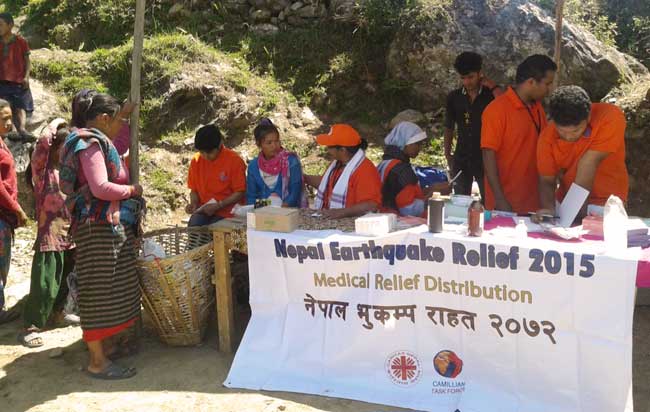Madhu is a member of the Camillian Task Force, which is partnering with Caritas Nepal to provide medical care to communities devastated by the earthquake. For the past few weeks, Madhu and 14 fellow team members have hiked mountainous terrain, witnessed landslides and lived in tents, in order to reach the most remote communities in Gorkha, the epicentre of the 25 April earthquake in Nepal.
Madhu explains some of the access challenges in reaching remote and isolated communities in Gorkha: “On the way to Kashigauw, we started off as two groups. We went halfway by vehicle, but then from there, there was no other way – we had to walk. So carrying all the medicines, we walked one day. From morning till evening we walked, but that was only halfway.”

Caritas Nepal team hiked mountainous terrain to provide medical assistance to remote areas in Nepal. Photo by Cammillian Task Force
At that point, a fortnight after the first earthquake, Madhu and his team had reached the village of Manbu. They found that Manbu also had not received any medical assistance so far, so half the team stayed there and set up a medical camp. The next day, Madhu and the other half of the team proceeded to Kashigauw – another day’s walk.
“On the way, when we were climbing the hill, another earthquake struck, on the 12th of May. On one side of the hill, we could see a landslide going on; and on the other side, we were climbing.”
Setting up medical camp in Kashigauw
“Finally we reached Kashigauw,” said Madhu. “We saw the situation was very poor, and the people were very poor. There were no road facilities there; the only way to reach there is by walking. More than 90% of houses were completely destroyed.”
“We saw 250 patients in three days. There were about 25 diarrhoea cases… Indirectly, I would say diarrhoea is related to the earthquake. Because they are living outside, and their water system is disturbed,” he explained. “Hygiene was very poor there, so we gave health education. We also carried with us the water purifier tablets and taught them how to use them.”
After running three days of medical clinic in Kashigauw, the team then walked two days back down the hill to rejoin the rest of their group, where they rested and recovered for two days.
Earthquake related injuries
With fresh energy, the team then travelled to Simjung. Again, the vehicle had to stop on the way, and the team had to trek another three hours to reach the village.

Medical relief distribution by Caritas Nepal and partner. Photo by Cammillian Task Force
In Simjung, the team saw around 500 patients. People presented with earthquake-related injuries such as sprains, fractures and wounds. “Maybe because of the environment, there were a lot of falls and cuts. For us, we were doing an average of 50 dressings per day,” says Madhu.
“There is one patient, can you go and see her?”
Madhu particularly recalls one woman they met in who was in a life-threatening state. “She delivered in the hospital with a Caesarean, and came back home. When we reached [the village], they said, “there is one patient; can you go and see her?” When we reached there it was really horrible. The wound was all infected and fully open. We were sure that if it continued like that, she was going to die.” After dressing the wound, Madhu and his team spoke with the Village District Committee officer, and organised for her to be transported to hospital.
Life after the earthquake
The earthquake and continued aftershocks have also had significant impacts on the women, men and children’s stress and anxiety levels. “There is a lot of anxiety amongst the people, because there are tremors every day,” said Madhu.
While running the medical camps, Madhu and the team stayed in tents overnight, just like many of the local people. “In the night when there are tremors, we hear everyone shouting. Mothers are crying out for their children, to check whether they are here, to make sure they are safe. It’s a kind of different world. They don’t know what will happen the next moment. That was something we really experienced being there and living in the tent.
“And then it rains,” continued Madhu. On top of the anxiety of continued aftershocks, the people are also dealing with the weather. “We had a little better tents, I would say, and we were struggling to hold it down during the heavy rain. I could imagine how much the people with just one tarpaulin were struggling.”
“So I think it’s not just what we have done,” said Madhu. “But also what we experienced – a little bit of what the people are really going through.”
